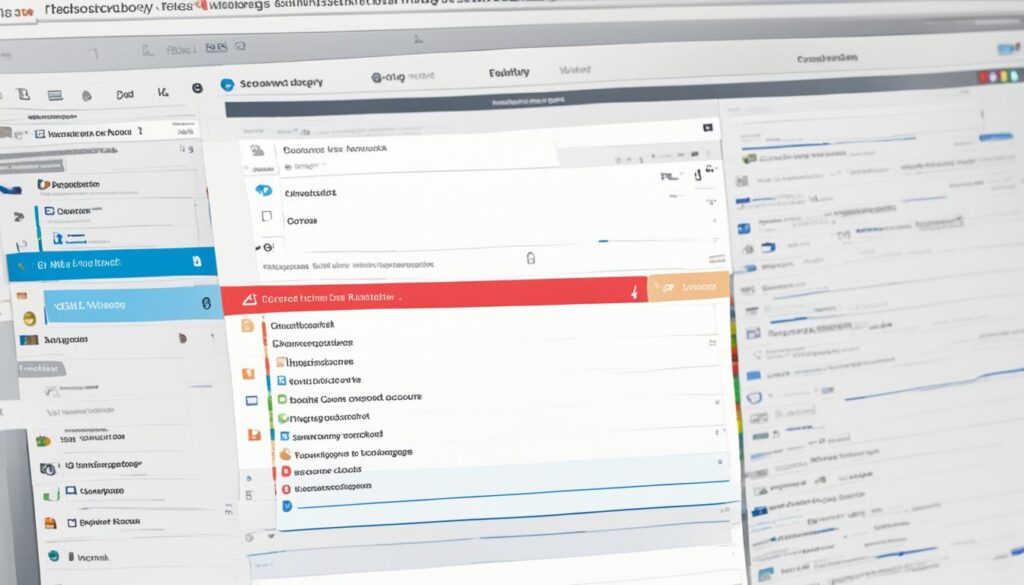Welcome to our guide on the best email management software for 2024. In today’s digital age, managing emails efficiently is vital for both businesses and individuals. With the increasing volume of emails we receive daily, it’s easy to get overwhelmed and lose track of important messages. That’s where email management software comes in. These powerful tools help you organize your inbox, prioritize emails, and enhance collaboration, enabling you to stay on top of your email game.
Whether you’re a busy professional juggling multiple email accounts or a team working together on projects, the right email management software can significantly boost your productivity and streamline your communication workflow. In this article, we will explore the top picks for the best email management software in 2024, highlighting their key features and benefits.
But before we dive into the details, let’s first understand what email management software is and why it is essential in today’s fast-paced digital world.
What is Email Management Software?
Email management software refers to applications or tools designed to help users effectively manage their email communication. These software solutions provide features such as inbox organization, collaboration capabilities, email filtering, automated responses, integration with calendar and tasks, and analytics and reporting. They help users streamline their email workflow, save time, and improve productivity.
Email management software is essential for businesses and individuals who receive a high volume of emails daily. These tools help users organize their inboxes, prioritize emails, and enhance collaboration.
With email management software, you can:
- Efficiently organize your inbox and categorize emails based on priority
- Collaborate with team members, allowing seamless communication and file sharing
- Automatically filter and sort incoming emails, reducing clutter
- Set up automated responses for common inquiries, saving valuable time
- Integrate your email with your calendar and task management tools for better planning and organization
- Analyze email communication trends and metrics to gain insights into your productivity
By leveraging the capabilities of email management software, you can stay on top of your inbox, efficiently handle email-related tasks, and focus on what matters most. It’s a valuable tool for individuals and businesses looking to improve their email management practices.
Benefits of using email management software
Email management software offers numerous benefits that can greatly enhance your email management efficiency:
| Benefits | Description |
|---|---|
| Improved organization | Efficiently organize your inbox and structure emails based on priority or categories. |
| Enhanced collaboration | Collaborate with team members by sharing emails, discussing tasks, and improving communication. |
| Time savings | Automate repetitive tasks, set up filters, and use templates to save time in managing your emails. |
| Better productivity | Reduce distractions, prioritize important emails, and focus on high-value activities. |
| Streamlined workflow | Integrate your email with other tools, such as calendars and task managers, for a seamless work experience. |
| Data-driven insights | Analyze email metrics and trends to gain valuable insights and optimize your email communication. |
Key Features of Email Management Software
Email management software offers a range of key features that enhance email organization and efficiency. These features include:
-
Inbox Organization:
Categorize and prioritize emails within your inbox to ensure you never miss important messages. With email management software, you can create folders, labels, or tags to organize your emails based on topics, senders, or urgency.
-
Collaboration Capabilities:
Collaborate seamlessly with your team by sharing emails, assigning tasks, or leaving comments within the software. Email management software facilitates efficient team communication and ensures everyone stays on the same page.
-
Email Filtering:
Reduce inbox clutter by setting up filters and rules to automatically sort incoming emails. You can classify emails as important, spam, or archive them based on specific criteria, such as sender, subject, or keywords.
-
Automated Responses:
Save time by setting up pre-defined templates or automated responses for frequently asked questions or common inquiries. With email management software, you can easily customize and schedule automated responses, ensuring prompt replies without manual effort.
-
Integration with Calendar and Tasks:
Efficiently plan and manage your schedule by integrating your email management software with your calendar and tasks. This integration allows you to turn important emails into tasks or create events directly from your inbox, keeping everything organized in one place.
-
Analytics and Reporting:
Gain valuable insights into your email communication trends and metrics. Email management software provides analytics and reporting features to track email response times, average email volume, and other key performance indicators, helping you identify areas for improvement.
Implementing email management software with these essential features can significantly improve your email organization, streamline your workflow, and boost your productivity.
“Email management software provides essential tools to stay organized, collaborate effectively, and enhance productivity in today’s fast-paced digital world.”
Example:
Here’s an example of how email organization could look with email management software:
| Folder/Label | Description |
|---|---|
| Inbox | Primary folder for all incoming emails |
| Important | Emails that require immediate attention or action |
| Work | Emails related to work projects and tasks |
| Personal | Emails from family, friends, or personal contacts |
| Archived | Emails that are no longer actively needed but may require reference in the future |
| Spam | Unwanted or promotional emails |

Image: Visual representation of the features offered by email management software.
Top Email Management Software for 2024
In 2024, there are several top email management software options available. These include Hiver, Microsoft Outlook, SaneBox, Front, Help Scout, Missive, Zendesk, Mailbird, and Zoho Mail. Each of these software solutions offers unique features and benefits to help you effectively manage your email communication and improve productivity.
Hiver
With Hiver, you can seamlessly collaborate on emails with your team, manage shared email accounts, assign tasks, and track their progress. Its shared inbox feature ensures that no email is left unanswered and allows you to effortlessly manage customer support, sales, and other shared inboxes.
Microsoft Outlook
As a widely-used email client, Microsoft Outlook provides a robust set of email management tools. It offers features such as email categorization, powerful search capabilities, customizable filters, and advanced calendar integration. With Outlook, you can stay organized and prioritize your emails effectively.
SaneBox
SaneBox uses artificial intelligence to automatically filter your emails and prioritize them based on importance. It moves non-essential emails to a separate folder, keeping your inbox clutter-free and allowing you to focus on what matters most. SaneBox also provides email tracking, snooze options, and one-click unsubscribe functionality.
Front
Front is an email management solution designed for teams. It enables seamless collaboration, shared inboxes, and real-time internal comments. With Front, you can assign emails to specific team members, reply together, and track progress. It also integrates with various third-party apps, streamlining your workflow.
Help Scout
Help Scout is a customer service-focused email management platform. It allows you to manage customer conversations efficiently, track support requests, and provide personalized responses. Help Scout offers collaboration features, automation options, and performance analytics to help you deliver exceptional customer service.
Missive
Missive combines email, collaboration, and chat features in one platform. It allows teams to collaborate on emails, create shared drafts, assign tasks, and chat internally without leaving the inbox. Missive’s seamless integration and real-time communication streamline team collaboration and enhance productivity.
Zendesk
Zendesk is a comprehensive customer support platform that includes email management capabilities. It provides a centralized inbox for managing customer inquiries, automated ticket assignment, and response templates. Zendesk’s reporting and analytics features help you gain insights into your team’s performance and improve customer satisfaction.
Mailbird
Mailbird is an email client that offers a user-friendly interface and various customization options. It supports multiple email accounts, integrates with popular productivity apps, and provides email organization features such as snoozing, filtering, and quick previews. Mailbird’s simplicity and intuitive design make it a popular choice for email management.
Zoho Mail
Zoho Mail is an email management solution that offers a secure and ad-free email experience. It includes features such as mailbox organization, custom filters, rules and alerts, and comprehensive search functionality. Zoho Mail also provides collaboration tools, productivity features, and seamless integration with other Zoho applications.
When choosing the top email management software for your needs, consider your specific requirements, budget, and integration preferences. Evaluate the features offered by each software solution to find the one that aligns best with your email management goals and enhances your productivity.

Conclusion
Finding the best email management software for your needs can greatly improve your inbox productivity and overall efficiency. With options like Hiver, Microsoft Outlook, SaneBox, and other top software available in 2024, there are plenty of powerful tools to choose from.
Implementing an email management system allows you to streamline your workflow, stay organized, and reclaim your time. With features like inbox organization, collaboration capabilities, email filtering, automated responses, and integration with calendar and tasks, these software solutions are designed to enhance your email productivity.
Maximize your email management by selecting the best email productivity apps that align with your requirements and preferences. Whether you prioritize seamless team collaboration, advanced email filtering, or comprehensive analytics and reporting, there’s an email management software out there to meet your specific needs.
Don’t let your inbox overwhelm you. Take control of your email communication with the best email management software available in 2024 and experience a more organized and efficient email workflow.
FAQ
Why is email management software important?
Email management software is important because it helps users organize their inboxes, prioritize emails, and enhance collaboration. It streamlines email workflow, saves time, and improves productivity.
What features does email management software offer?
Email management software offers features such as inbox organization, collaboration capabilities, email filtering, automated responses, integration with calendar and tasks, and analytics and reporting.
What are some top email management software options for 2024?
Some top email management software options for 2024 include Hiver, Microsoft Outlook, SaneBox, Front, Help Scout, Missive, Zendesk, Mailbird, and Zoho Mail.
How can email management software improve productivity?
Email management software improves productivity by helping users streamline their workflow, stay organized, and reclaim their time. It allows for efficient email organization, collaboration, and automated responses.
How do I choose the best email management software for my needs?
To choose the best email management software for your needs, consider factors such as your specific requirements, budget, integration capabilities, customer reviews, and user-friendly interface. Evaluating these factors will help you make an informed decision.
